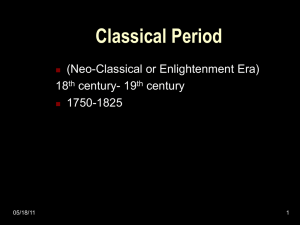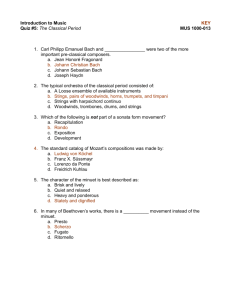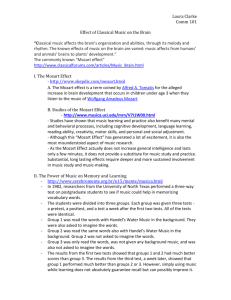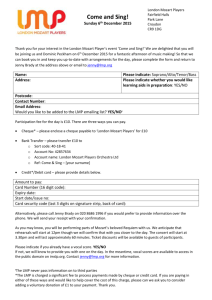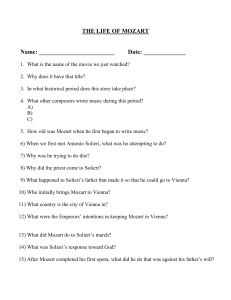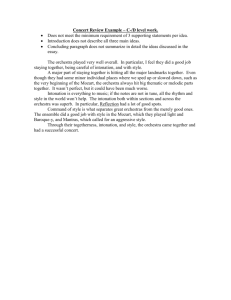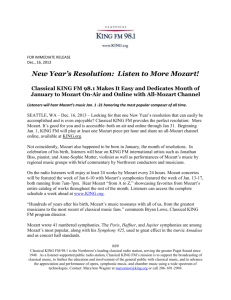the Program Notes from the concert in CT
advertisement
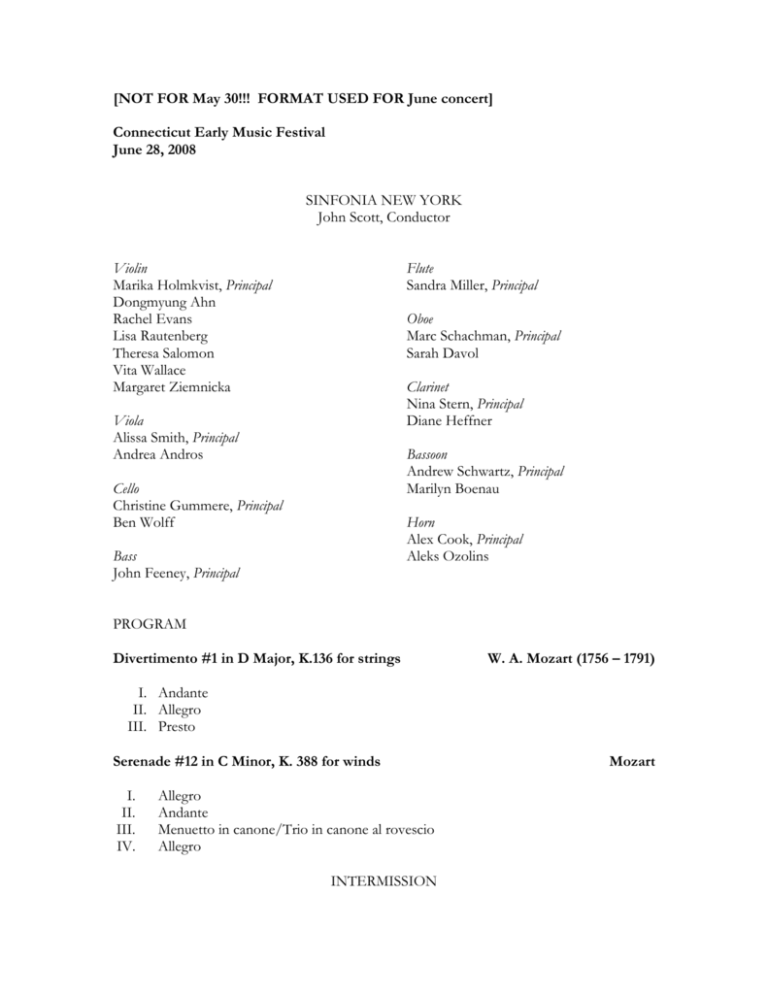
[NOT FOR May 30!!! FORMAT USED FOR June concert] Connecticut Early Music Festival June 28, 2008 SINFONIA NEW YORK John Scott, Conductor Violin Marika Holmkvist, Principal Dongmyung Ahn Rachel Evans Lisa Rautenberg Theresa Salomon Vita Wallace Margaret Ziemnicka Flute Sandra Miller, Principal Oboe Marc Schachman, Principal Sarah Davol Clarinet Nina Stern, Principal Diane Heffner Viola Alissa Smith, Principal Andrea Andros Bassoon Andrew Schwartz, Principal Marilyn Boenau Cello Christine Gummere, Principal Ben Wolff Horn Alex Cook, Principal Aleks Ozolins Bass John Feeney, Principal PROGRAM Divertimento #1 in D Major, K.136 for strings W. A. Mozart (1756 – 1791) I. Andante II. Allegro III. Presto Serenade #12 in C Minor, K. 388 for winds I. II. III. IV. Allegro Andante Menuetto in canone/Trio in canone al rovescio Allegro INTERMISSION Mozart Symphony #6 “Le Matin” Franz Joseph Haydn (1732 – 1809) I. Adagio - Allegro II. Adagio - Andante - Adagio III. Menuet e Trio IV Finale: Allegro NOTES ON THE PROGRAM Divertimento and Serenade of Wolfgang Amadeus Mozart (1756 – 1791) In 18th-century Europe music was as important for special social and ceremonial occasions as it is today. Without recordings and sound systems, however, composers and performers were kept busy constantly creating music for churches and cathedrals, aristocratic courts, and house parties, as well as for commercial concerts in public venues. A composer who traveled extensively, like Mozart, would often write anything from solo sonatas or pieces for small instrumental ensemble to a complete Mass to feed the appetite for music in the city in which he was sojourning. Among the most popular genres of music for social use were the divertimento and the serenade. These were pieces written purely for entertainment, rather than the more deliberate purposes of church or court. They were used at garden parties, weddings, birthdays, palace parties, informal gatherings, and similar occasions. In musical form they were related to other mid-18th-century genres including the symphony and the orchestral partita, but were typically more loosely structured. Both the divertimento and serenade originated in Italy with the practice of musicians traveling from house to house playing musical greetings to amuse one’s beloved or a person of rank, or in hopes of being paid. Visitors during the summers in Italy, as well as Germany, Austria, and Bohemia, often remarked on the practice. Many divertimenti begin and end with marches so that the players could arrive and depart to music, though the marches were often stripped from the published editions. The genre employed widely varying instrumentation, including winds and strings, were suitable for indoor or outdoor performance (there are records of even double bass players traipsing from venue to venue) and exploited such entertaining devices as the division of forces among adjoining rooms or florid solo writing, all in service of amusing the listeners. In time both terms, used interchangeably, came to mean a work of a particular character, formal structure, and instrumentation, of which Mozart’s serenades and divertimenti are the chief examples. The most famous string divertimento, Mozart’s K. 525, is famous as “Eine Kleine Nacht Musik.” One of Mozart’s letters describes a group of friends playing his own Serenade in E-flat K. 375 for him on his name-day in 1781 as a surprise which greatly lifted his spirits. The Divertimento No. 1 in D major K. 136 for strings is the first of a set of three that Mozart composed in 1772 when he was 16 years old. Although they can be called youthful works, they were written by a musician who had been playing, composing, and conducting since the age of seven. Mozart had already toured Europe several times, performing for royalty, famous musicians, and the general public. He had even been made a Knight of the Golden Spur, (the chivalric order honoring service to the Catholic Church) by the Pope. These lovely divertimenti are the work of a youthful but experienced professional who was beginning to explore old forms using his own voice. Form is executed perfectly, and his imagination is starting to take off. The D major Divertimento is a sunny, exuberant piece. It showcases the first violin but also gives the second violin and viola more expressive opportunities than usual. Mozart's bass lines had yet to develop into the wonderfully independent voices of his later string quartets, but they are still a joy to play. They are the equivalent of a great jazz rhythm section, propelling the upper voices and providing the harmonic foundation for their arias and acrobatics. The Serenade No. 12 in C minor K. 388 for winds is a favorite choice whenever wind players gather together for their own enjoyment. The classical wind octet comprising pairs of oboes, clarinets, bassoons and horns came into prominence in the 1780s, when the Austrian emperor Josef II established the Kaiserlich-Kšniglich Harmonie with these forces. Quickly copied throughout the princely courts of the Hapsburg empire, its principle function was to play background music for informal occasions. The repertoire consisted of original pieces (often titled Divertimento or Serenade), as well as arrangements of orchestral pieces (there are contemporary arrangements of Mozart's later operas and even of complete Beethoven symphonies). Mozart's Serenade in C Minor was probably composed in July 1782 during the composer’s first years in Vienna after leaving Salzburg. This period is generally considered the start of Mozart’s mature writing, and the Serenade reflects this shift. While serenades frequently contain more than four movements, this work has just four, and closely parallels the symphony in structure and seriousness. A listener expecting some light entertainment is in for a bit of a shock, right from the opening’s unison C minor arpeggio, a key that Mozart often used for his most serious work. The first movement remains dramatic and ominous throughout. The more relaxed and lyrical Andante employs a compositional device that has one instrument begin a melody, with the remainder passed to another voice in the ensemble. The minuet is in the form of a canon (or “round”): the oboe introduces the melody, echoed by the bassoon. Its trio takes the form of an inverted canon, whereby each melodic entry is the inversion of its predecessor-- what went upward goes downward. This exercise in counterpoint illustrates Mozart’s command of the most serious compositional techniques, although he never lets this technical trick get in the way of the music. The final movement is a theme and variations, with ample evidence of Mozart’s attention to texture and variety. Symphony of Franz Joseph Haydn (1732 – 1809) In contrast to Mozart’s childhood as a traveling prodigy, Haydn’s early years were ones of struggle. He was born in the Austrian village of Rohrau near the Hungarian border into a family of humble farmers. He went to Vienna as a choirboy, but was later thrown into the streets when his voice broke, and forced to endure a decade of poverty as a freelancer. He took jobs as a street serenader, music teacher, even a valet. His reputation as a musician and composer grew however, and he came to the attention of aristocratic patrons, essential for composers of that time. He finally found steady employment with the Esterházy family, one of the richest and most prominent in the Austrian empire. Part of the family retinue, he traveled among their various homes in Hungary, including the grand Eszterháza palace in a rural area of the country. He was responsible for composing, directing the orchestra, playing chamber music, and producing operas. Fortunately, the Esterházy princes were connoisseurs, and the stability and isolation of the palace enabled Haydn to develop his musical style with a stable ensemble of accomplished musicians. Permitted to travel after 25 years of service to the family, he was received triumphantly in courts and capitals, capped by two sojourns in London. The Symphony #6 is a milestone in Haydn's career. Le matin was the first symphony composed for his new employer, Prince Esterházy, in the spring of 1761. The title refers to the depiction of a sunrise in the opening slow introduction; it is tempting to view this as symbolic of the dawn of Haydn's success. As one of his early works, Haydn maintained the familiar tradition of the concerto grosso, providing virtuoso solos for violin, viola, cello, and even string bass in addition to those expected for the winds. The slow movements are meltingly beautiful, while the allegros reflect the sunny disposition for which Haydn is known. The symphony is at once a challenge to and a vote of confidence in his new ensemble – as it is for Sinfonia New York today. ABOUT SINFONIA NEW YORK Sinfonia New York is the realization of the dreams of two of New York’s most experienced performers of baroque and classical music, ‘cellist Christine Gummere and flutist Sandra Miller. They, like most of their colleagues in the orchestra, have been involved in the “historically informed performance” movement in the United States for well over twenty years, devoting their professional careers to increasing their knowledge and perfecting their skills as soloists, and as chamber music and orchestral players. Sinfonia New York was formed to expand the opportunity to hear works of the Baroque and Classical eras played by seasoned professionals on the instruments and in the style appropriate to the period. The orchestra is based on collaborative principles by which members have a voice in governance and artistic direction. To encourage the highest level of ensemble playing, key roles are shared among core members, and the performing repertoire includes chamber music as well as symphonic literature. Further, the orchestra took special care in choosing John Scott as conductor, whose musicianship, conducting skills, and collaborative style they respect and admire. Following its debut at New York’s Town Hall on October 1, 2007, the orchestra presented a second concert in New York City in May, 2008. It is appearing at the Connecticut Early Music Festival in June, and will perform the modern premier of the newly-discovered Mass in A Major by Franz Xaver Richter, an admired contemporary of Mozart, at Saint Thomas Church with the Choir of Men and Boys on October 16, 2008.
